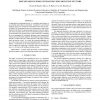Free Online Productivity Tools
i2Speak
i2Symbol
i2OCR
iTex2Img
iWeb2Print
iWeb2Shot
i2Type
iPdf2Split
iPdf2Merge
i2Bopomofo
i2Arabic
i2Style
i2Image
i2PDF
iLatex2Rtf
Sci2ools
ICASSP
2009
IEEE
2009
IEEE
Instantaneous pose estimation using rotation vectors
An algorithm for estimating the pose, i.e., translation and rotation, of an extended target object is introduced. Compared to conventional methods, where pose estimation is performed on the basis of timeof-flight (TOF) measurements between external sources and sensors attached to the object, the proposed approach directly uses the amplitude values measured at the sensors for estimation purposes without an intermediate TOF estimation step. This is achieved by modeling the wave propagation by a nonlinear dynamic system comprising a system and a measurement equation. The nonlinear system equation includes a model of the time-variant structure of the object rotation based on rotation vectors. As a result, the measured amplitude values at the sensors can be processed instantaneously in a recursive fashion. Uncertainties in the measurement process are systematically considered by employing a stochastic filter for estimating the pose, i.e., the state of the nonlinear dynamic system.
Amplitude Values | ICASSP 2009 | Intermediate Tof Estimation | Nonlinear Dynamic System | Signal Processing |
Related Content
| Added | 21 May 2010 |
| Updated | 21 May 2010 |
| Type | Conference |
| Year | 2009 |
| Where | ICASSP |
| Authors | Frederik Beutler, Marco F. Huber, Uwe D. Hanebeck |
Comments (0)

